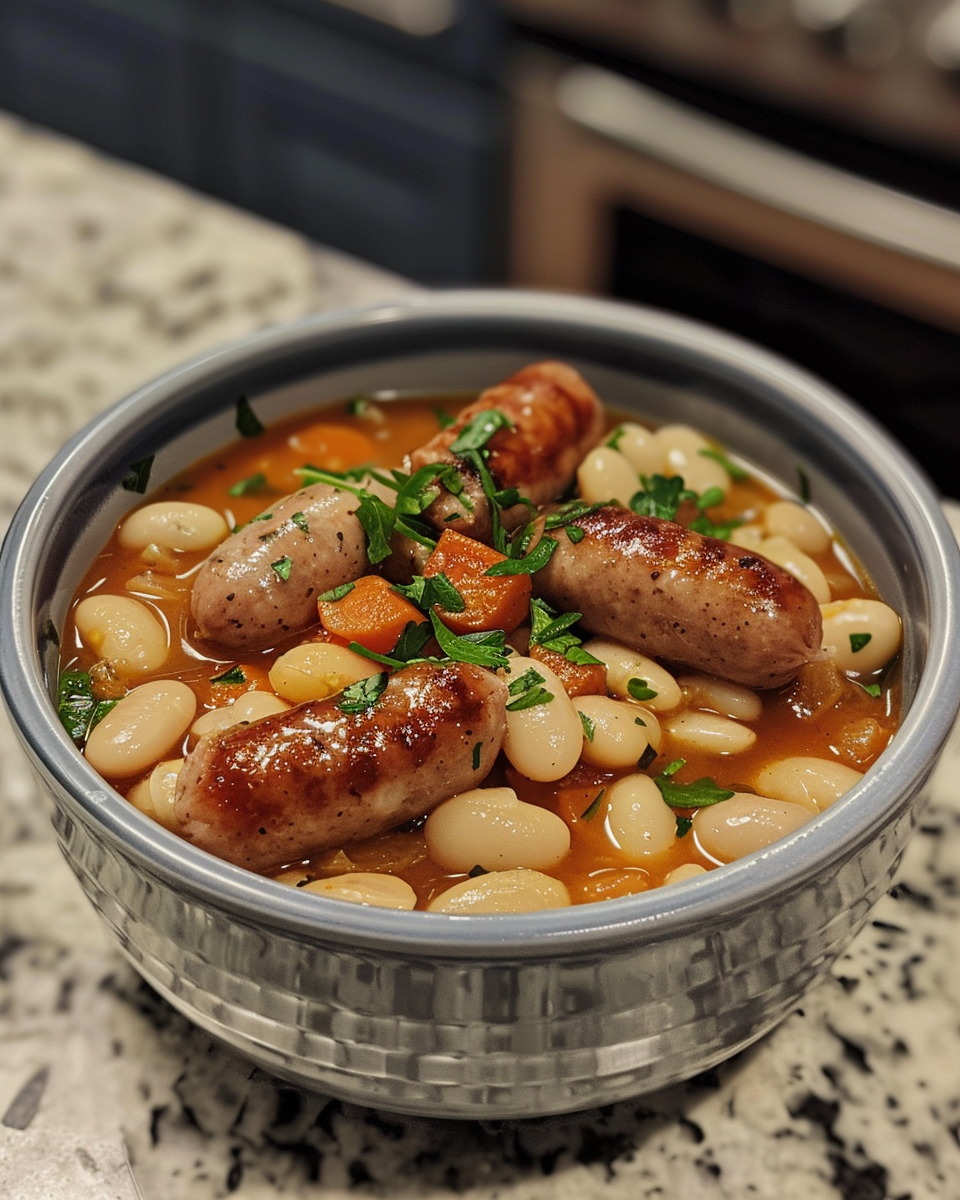Introduction
There’s something undeniably comforting about a warm bowl of white beans and sausage. The blend of creamy beans, hearty sausage, and aromatic herbs creates a dish that is both flavorful and satisfying. It’s the kind of meal that warms you from the inside out, making it perfect for cold nights or when you’re craving something substantial yet simple.
Brief History: The origins of white beans and sausage dishes can be traced to various regions, each with its twist. French cassoulet, a slow-cooked casserole of beans and meats, is one of the most famous versions. In the Southern U.S., dishes like red beans and rice or white bean stews often feature sausage, especially during the colder months. Each version, whether from France or the American South, celebrates the humble bean and the robust flavor of sausage.
Why It’s Popular: This dish is not only delicious but also incredibly nutritious. White beans are packed with fiber and protein, making them an excellent choice for a balanced meal. The dish is also versatile, allowing for endless variations. Whether you prefer a spicy sausage or a milder one, or if you want to add vegetables or keep it simple, this recipe can adapt to your preferences.
Personal Touch: One of the reasons this recipe is a favorite is its simplicity. After a long day, there’s nothing easier than throwing together a pot of white beans and sausage. It requires minimal prep but delivers maximum flavor, making it perfect for busy weeknights or meal prepping for the week.
Overview of the Recipe: In this recipe, we will use creamy white beans such as cannellini or navy beans, paired with flavorful sausage and a selection of herbs like thyme, rosemary, and bay leaves. A rich broth will tie everything together, creating a dish that’s both hearty and flavorful.
Ingredients
White Beans: The star of the dish, white beans are soft, creamy, and absorb the flavors of the sausage and herbs beautifully. Cannellini beans are a popular choice, but navy beans or great northern beans are excellent alternatives. Each type has a slightly different texture, with cannellini beans being creamier and navy beans having a firmer bite.
Sausage: The choice of sausage greatly influences the flavor of the dish. Spicy Italian sausage adds a bit of heat, while smoked sausage imparts a deep, smoky flavor. Andouille, a staple in Cajun cooking, brings a bold, peppery kick. If you prefer a milder flavor, a traditional pork sausage will do the trick.
Vegetables: Adding vegetables such as onions, garlic, celery, and carrots adds depth to the dish. These aromatics form the base of the stew, infusing it with subtle sweetness and umami flavor.
Herbs and Spices: Fresh herbs like thyme and rosemary add earthy flavors, while bay leaves enhance the broth’s complexity. If you enjoy a little spice, a pinch of red pepper flakes adds just the right amount of heat.
Broth or Stock: A good quality chicken or vegetable broth provides richness and ties the flavors together. It’s best to use homemade broth, but store-bought works well in a pinch.
Optional Additions: For a nutritional boost, you can add kale or spinach towards the end of cooking. Tomatoes can also add brightness and acidity to balance the richness of the sausage.
Substitutions: For those who follow a vegetarian or vegan diet, substitute the sausage with a plant-based option. There are many great vegan sausages available that mimic the flavor and texture of traditional sausage. Use vegetable broth instead of chicken broth for a completely vegetarian meal.
Seasoning: Salt, pepper, and a touch of red pepper flakes are all you need to season this dish. You can adjust the seasoning towards the end, depending on the saltiness of your sausage and broth.
Instructions (Step-by-Step)
Step 1: Preparing the Beans
- Soaking the Beans: If using dried beans, soak them overnight in plenty of water. This will reduce cooking time and make the beans easier to digest. Drain and rinse the beans before using.
- Quick-Soak Method: If you’re short on time, you can use the quick-soak method. Bring a pot of water to a boil, add the beans, and let them simmer for 2 minutes. Remove from heat, cover, and let the beans soak for 1 hour.
- Using Canned Beans: If you’re in a hurry, canned beans are a great substitute. Rinse and drain them before adding them to the dish to remove excess sodium.
Step 2: Browning the Sausage
- Heat the Pan: Add a tablespoon of olive oil to a large skillet or Dutch oven over medium heat. Once hot, add the sausage and cook until browned on all sides, about 5-7 minutes. This step is crucial as it renders the fat from the sausage, which will add flavor to the dish.
- Sautéing Vegetables: Remove the sausage and set it aside. In the same pan, add the onion, garlic, celery, and carrots. Cook until softened and fragrant, about 5 minutes. Scrape up any brown bits left from the sausage to incorporate more flavor into the vegetables.
Step 3: Building the Broth
- Adding Broth: Pour in 4 cups of chicken or vegetable broth. Stir well, scraping the bottom of the pan to deglaze. This will form the base of your stew.
- Seasoning the Dish: Add thyme, rosemary, and bay leaves to the pot. These herbs will infuse the broth with their earthy flavors as the beans and sausage cook.
Step 4: Cooking the Beans and Sausage
- Simmering the Beans: Add the soaked or canned beans to the pot. Stir everything together and bring the mixture to a simmer. Let it cook on low heat for 30-45 minutes, or until the beans are tender and the broth has thickened slightly.
- Adjusting Texture: If you prefer a thicker consistency, mash some of the beans with the back of a spoon or an immersion blender. For a soupier texture, add more broth.
- Timing: Be sure to check the beans periodically to ensure they don’t overcook and become mushy.
Step 5: Optional Additions
- Adding Greens: For added nutrition, stir in kale or spinach about 10 minutes before the end of cooking. These greens will wilt quickly but add a fresh, vibrant element to the dish.
- Finishing Touches: Taste the stew and adjust the seasoning. Add more salt, pepper, or red pepper flakes if needed.
Step 6: Final Simmer
- Allow the dish to simmer for an additional 10 minutes. This will give the flavors a chance to meld together beautifully.
Serving Suggestions
Presentation: Serve the white beans and sausage in deep bowls, garnished with fresh herbs like parsley or thyme. A drizzle of olive oil or a sprinkle of Parmesan cheese can elevate the presentation and flavor.
Pairings:
- Bread: Crusty bread, garlic bread, or cornbread are perfect for soaking up the flavorful broth.
- Salad: A light green salad with a tangy vinaigrette complements the richness of the dish.
- Side Dishes: Consider serving roasted vegetables or steamed rice on the side for a complete meal.
Wine Pairing: For wine enthusiasts, a glass of Sauvignon Blanc, with its crisp acidity, pairs wonderfully with the dish. If you prefer red wine, a light-bodied Pinot Noir works well without overpowering the flavors.
Serving Size: This recipe typically serves 4-6 people, making it ideal for family dinners or meal prep for the week. The leftovers taste even better as the flavors continue to develop.
Leftovers: Store any leftovers in an airtight container in the fridge for up to 3 days. The dish can also be frozen for up to 3 months. When reheating, you may need to add a little broth to loosen the stew.
Conclusion
This bowl of white beans and sausage is the perfect comfort food. With its rich, savory flavors and satisfying texture, it’s a dish that pleases a crowd and keeps well as leftovers. Whether you choose to experiment with different sausages or beans, this recipe is endlessly adaptable. The ease of preparation and the depth of flavor make it a must-have in any home cook’s repertoire.
FAQs
Can I make this dish with canned beans instead of dried beans?
Yes! Canned beans are a great time-saving alternative. Be sure to drain and rinse them before use, and reduce the cooking time since canned beans are already cooked.
What type of sausage works best for this recipe?
Spicy Italian sausage, smoked sausage, or Andouille are excellent choices. Each brings a different flavor profile, so choose according to your preference.
Can I make this dish vegetarian or vegan?
Absolutely! Use a plant-based sausage and substitute vegetable broth for chicken broth to create a delicious vegetarian or vegan version.
How do I thicken the broth if it’s too watery?
If you prefer a thicker stew, mash some of the beans or let the dish simmer uncovered for a few extra minutes to reduce the liquid.
Can I freeze leftovers?
Yes, this dish freezes well. Store it in an airtight container for up to 3 months. When reheating, add a bit of broth to bring it back to the desired consistency.
How can I add more vegetables to this recipe?
You can easily incorporate vegetables like bell peppers, zucchini, or root vegetables like carrots and parsnips. Add them in step 2 when sautéing the aromatics.
Can I use a slow cooker or Instant Pot to make this recipe?
Yes, both methods work well! In a slow cooker, combine all the ingredients and cook on low for 6-8 hours. For the Instant Pot, use the sauté function for the sausage and vegetables, then cook on high pressure for 25-30 minutes.

